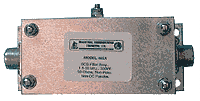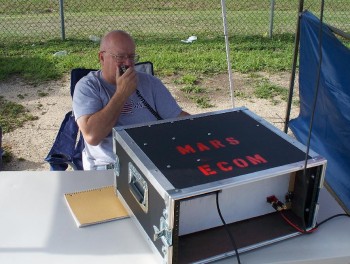A FEW TIPS FOR ANY FIELD DAY OPERATION – I’ve posted these a few years ago, but I think they should be repeated.
1. When setting up antennas within close proximity: If you are using wire antennas such as dipoles, and they run parallel to each other there will be interference on your HF operating bands in the form of hash so arrange them at right angles to each other and at slightly different heights. If you use wire antennas such as dipoles, try to stay away from trap dipoles and use full length antennas instead. You may also wish to run your dipoles in different configurations such as have one as an “inverted V” and another as a sloper, etc. An antenna cut to the exact band you are using will decrease interference to and from other bands. Do not use compromise or “all band” antennas. On HF, stay away from vertical antennas as they receive too much man-made noise from sources such as generators, etc.
 2. When operating within a tight area, as required by FD rules, it also pays to use “band pass filters” such as those manufactured by ICE. I have a full set of these HF filters and they work great. They are only about $ 38 per band and drastically reduce interference from your other operating posts. If your pocketbook can’t afford them, use coax “stub” filters. The lengths of these and how to build them can be found at: http://www.k1ttt.net/technote/k2trstub.html They are simple to make and easy to use. Both systems have been used by the major DXpeditions all over the world with great success. On HF frequencies make sure each operating station is properly grounded. Do NOT use a common ground for all your operating posts.
2. When operating within a tight area, as required by FD rules, it also pays to use “band pass filters” such as those manufactured by ICE. I have a full set of these HF filters and they work great. They are only about $ 38 per band and drastically reduce interference from your other operating posts. If your pocketbook can’t afford them, use coax “stub” filters. The lengths of these and how to build them can be found at: http://www.k1ttt.net/technote/k2trstub.html They are simple to make and easy to use. Both systems have been used by the major DXpeditions all over the world with great success. On HF frequencies make sure each operating station is properly grounded. Do NOT use a common ground for all your operating posts.
3. Make sure that each operating position has a laminated chart of frequencies that can be used under your station’s or club’s operating license. Watch out and don’t operate too close to the band edges. (remember: no one “owns” a frequency)
4. If using computer logging, always have paper logs and scratch pads ready to use in case your computers bog down or crash. (ever use a “dupe sheet”? Don’t know what it is? Find out!)
5. Whenever I operate either in contests or operating events, I find it advantageous to camp out (remain on) a frequency rather than tune around (hunt and pounce). Remember that propagation conditions will change so stick with it even if you think the band has died or other stations appear on your frequency that weren’t there earlier. That’s just how propagation works.
6. Keep your calling frequency active by calling CQ often. Don’t wait! Leave a gap of only 4 seconds between calls or stations tuning by will miss your call and other stations  wishing to camp out may take over your frequency. In events such as FD, it also pays to use an automatic voice unit such as MFJ 434B “voice keyer”. (Cost is about $170.) If you can’t obtain one, use a cheap electronic memo reminder and just play back your pre-recorded CQ while holding it close to your microphone. This form of “acoustic coupling” is an inexpensive way to save your voice. I have used both methods over the years with success. Keep your calls “short and sweet” using ITU phonetics ONLY. Don’t use any “cutesy” phonetics.
wishing to camp out may take over your frequency. In events such as FD, it also pays to use an automatic voice unit such as MFJ 434B “voice keyer”. (Cost is about $170.) If you can’t obtain one, use a cheap electronic memo reminder and just play back your pre-recorded CQ while holding it close to your microphone. This form of “acoustic coupling” is an inexpensive way to save your voice. I have used both methods over the years with success. Keep your calls “short and sweet” using ITU phonetics ONLY. Don’t use any “cutesy” phonetics.
7. If you are lucky enough to cause a “pile up” (several stations calling you at once) answer the easiest one to hear first. If you can’t make out complete callsigns, ask for the station with the easiest partial call to reply. The others will wait. Do not get flustered.
8. Ignore jammers. Do NOT bother answering them.
9. Have your station’s callsign and exchange info posted in large letters at your operating position in case you get a bit tired so you won’t forget and announce your own call by mistake.
10. If possible, bring your own headphones to make your life easier and to cut down on ambient noise from your area.
11. Talk in a loud, clear voice. No need to shout as it distorts your signal. Speak in to the microphone at an angle.
12. Pace yourself, drink plenty of fluids and let whomever is in charge know when you need a break. Do NOT be a “mic hog” as other people may wish to gain the experience of operating.
13. Learn a bit about propagation characteristics for each band and time of day before you come to FD.
14. If there are enough people, have someone do the logging for you. This way they will learn to copy callsigns under less than perfect situations and will make life easier for you. A “double set of ears” makes it easier to operate and log. It might even entice non-hams to get their license.
15. If you want your FD to be more successful, WAIT until all members have arrived before deciding what amount of stations you wish to put on the air for the event. You can always change bands, even with a 1A station. Years ago one club I was a member of decided to operate 20A ! That’s 20 stations operating. The only problem was there wasn’t enough people to man all the stations for the length of FD, so we were stuck at times with 10 stations we couldn’t use. You can’t change your exchange once the event starts. Talk about bad planning.
16. Flag all coax runs, power cords and antenna guy lines with brightly colored caution tape so no one walks into them or trips over them.
17. Never assume you’ve “worked them all”. In 1991 a pair of inexperienced ops came out of the 40 meter SSB tent claiming they “worked the band dry”. I told them they hadn’t and taking another op to log for me, in 30 minutes I worked an additional 60+ stations on that “dry band”. Lesson learned: There are always other stations out there to work.
18. Know the rig you are operating by reading each radio’s instruction manual. By doing so you’ll avoid problems and make more contacts. Be especially careful of the filters in complex radios as they could filter out wanted signals. Keep your operations simple so the next person assigned to your station won’t get confused twisting and turning knobs!
19. Turn off all gear during refueling of any gas generators. Use proper saftey procedures so voltage spikes won’t harm your radios. This means to turn off your radios BEFORE the generator shuts off and wait until it reaches operational speed before turning your gear back on. You can get voltage spikes during the shutting off of the generator and the start up cycle. Use care when refuelling the generator and NEVER gas it up while it is running. A gas spill even when the generator is off but HOT can also spell disaster.
20. Learn , but most of all : Have fun. (also, have your license handy… it’s an FCC requirement)
73 W2IK

 2. When operating within a tight area, as required by FD rules, it also pays to use “band pass filters” such as those
2. When operating within a tight area, as required by FD rules, it also pays to use “band pass filters” such as those 
